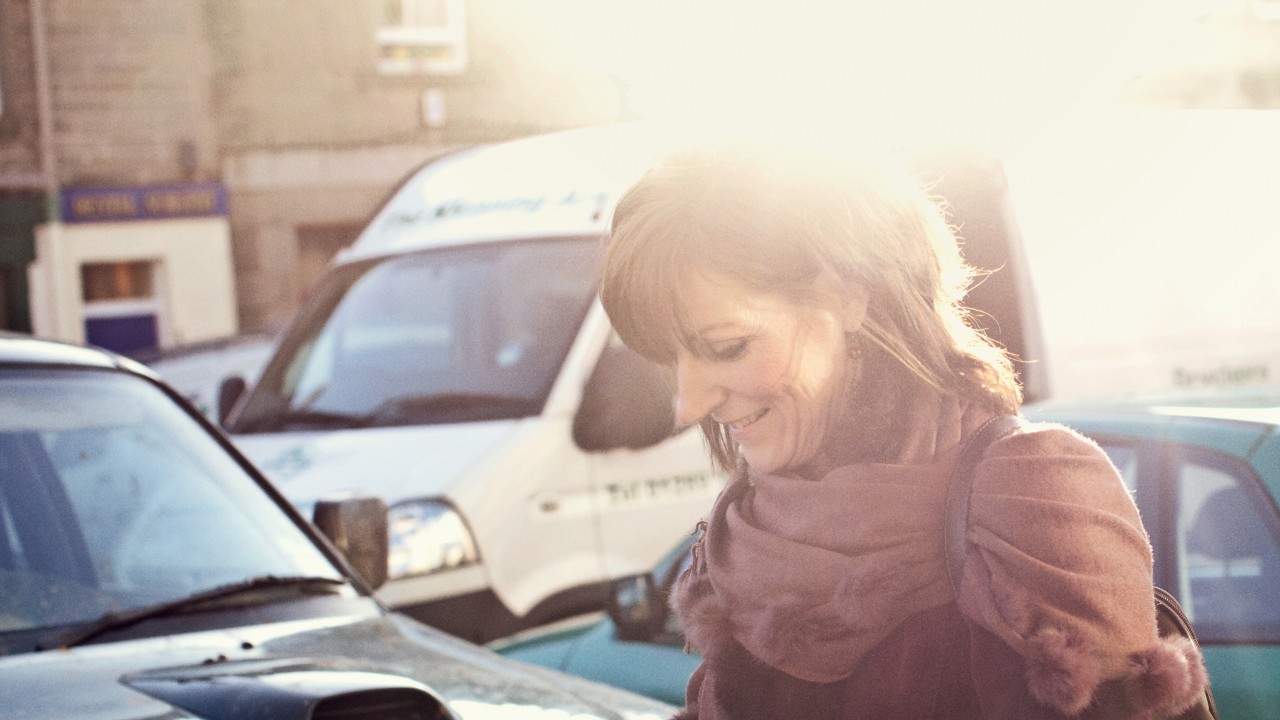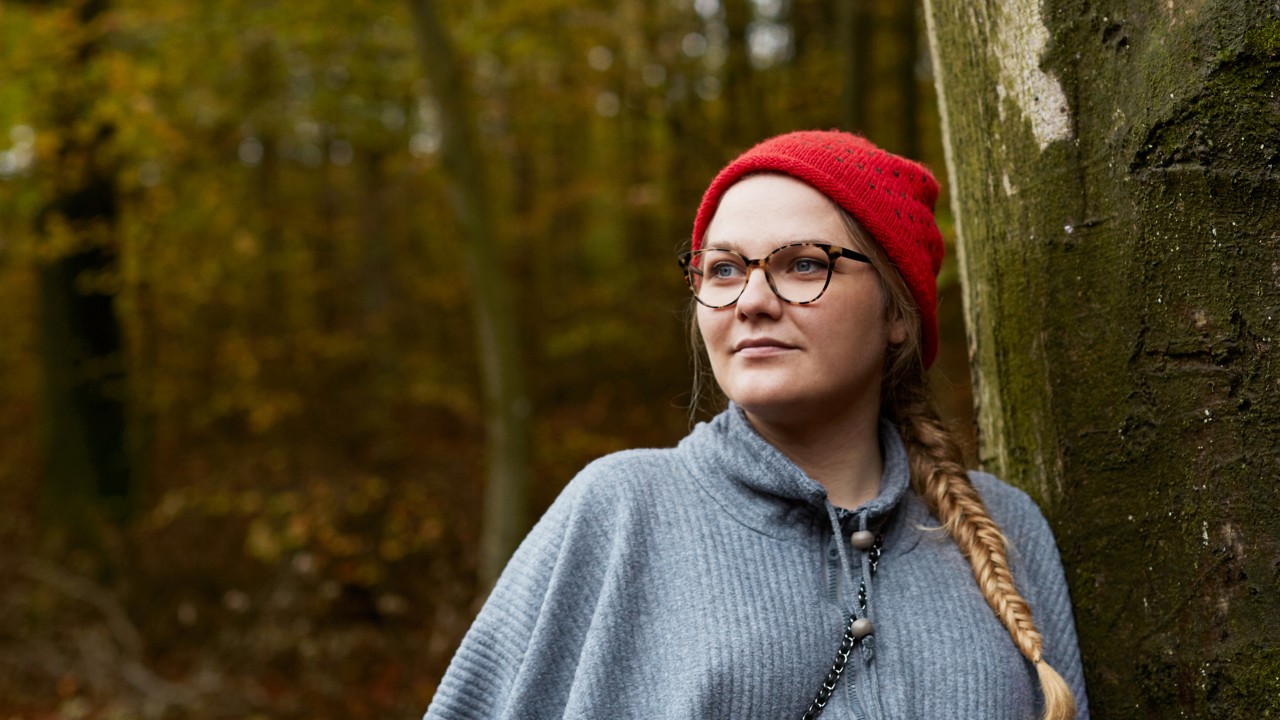

Ditte Grauen Larsen
The Eyes Follow Her, Unblinking
Ditte Grauen Larsen
Denmark26 years old. Living with her boyfriend and expecting a child.
Employment
Primary Schoolteacher.
Diagnosis
In 2012, Ditte was Diagnosed with paranoid schizophrenia.
Someone who mumbles to themselves on the bus – drunk, perhaps? Perhaps crazy? Anyone can spot a person like that from far away, says Ditte, and would quickly avert their gaze and sit somewhere else. Back in her schooldays, Ditte often felt that her classmates saw her that way. The odd girl. Today she still wonders why that happened. When she looks at her school photos, she sees an unassuming girl with long hair who doesn’t stand out at all. The girl in the school pictures is smiling. It’s a façade.
Her mother was diagnosed with a life-threatening brain tumour when Ditte was quite small, and the fear that her mother would die put her in a permanent state of alert. About the same time that her mother became ill, her parents divorced, and throughout her childhood, Ditte did her utmost not to be a bother. She was so agreeable that she was barely there, and once in a while she would disappear entirely. She disappeared into a magical world of fairy tale and fantasy, a world in which a family of gnomes might well be living under a stump in the forest. In that world, she herself was a pixie. And if some grownup frightened her with an outburst of anger, it was because the man was in fact a troll.
From 7th through 10th grade, Ditte had to endure a special form of agony – and like so much else, it was something she submitted to quietly. It might appear harmless: every morning she rode the bus to school, every afternoon, back home. But twice a day, the bus ride would hammer home the extent of her isolation. Ditte now thinks that her inner self fractured – right there on the school bus – sometime during 8th grade, long before she became mentally ill. Today, as an adult, she can see the 14-yearold Ditte before her on the bus. The cool kids are sitting in back, the losers in front. Teenage Ditte has seated herself in the first row of the back half, in the hope that she’ll be teased less than up front. The bus is jam-packed with rowdy students, shrieking with laughter. Are they making fun of her? She’s sure that they are. The seat next to her is empty. And grown-up Ditte says, “No fantasy can save that girl.”
A Better Girl
Time and again while she was growing up, Ditte tried to reinvent herself as “a new and better girl”, one who would fit in. She was tirelessly optimistic and pleasant. She wore the same clothes as the popular girls. She smiled and smiled, while behind this front, her inner world grew in strength. In many ways, it became far richer and more fun than her everyday life. If she grew bored during a class, she could self-hallucinate and make a teacher’s hair shift colour from white to purple. Or she could conjure up a small lion and watch it act out a scene from The Lion King on the teacher’s desk. But then her inner world began to leak into the outer world, and it did so in ways she couldn’t control. A host of obsessive thoughts began to haunt her: One of her teachers was a witch, and if the witch’s initials were on the bus’s number plate, Ditte couldn’t allow herself to get on. And she could only wear socks that weren’t the same, never ones that matched.
The storm in Ditte’s mind raged and gathered strength. Songs she’d heard in the course of the day piled up and played simultaneously. Thoughts whirled around with no object or focus. “All sense of direction vanished,” she explains.
“I couldn’t concentrate on just one thought, for there were a thousand others that were equally urgent.” Ditte Grauen Larsen
And simple actions could be lethal. To ride the witch’s bus would kill her mother. To put on tights with matching feet would kill her mother. The responsibility for keeping her mother alive rested on Ditte’s shoulders. During high school, Ditte started taking antidepressants. But the medicine didn’t change anything about her reality or her struggle to keep it hidden. “My façade meant everything to me,” she says today. “I used all my energy to maintain it.”
A turning point
The eyes did not blink, and they followed her, depending on where she was. Ditte had the sense that they wanted to make sure that she executed her compulsive actions correctly. The eyes were real. They were just as real as trees and as the leaves on trees, and it was from the leaves of the trees that the eyes were watching her. Ditte didn’t talk about the eyes, for perhaps it was perfectly normal to see them. Perhaps other people saw them too, and would judge her as weak because she was afraid of them. Or they would judge her as crazy, and in that case she would surely be committed and never let out again. Either way, she thought, to speak was more dangerous than keeping quiet. Ditte had travelled a great distance before she got to the place where the leaf-eyes onitored her.
Something in her core had cracked when she was around 14, and later, the cracks had deepened. They manifested as social anxiety, as depression, as obsessive thoughts and self-harm – until finally they erupted in psychosis. That was late 2012. She was 20 years old, and since graduation she’d been working in a supermarket. Several months before, she’d sought out a psychologist, who’d advised her to stop taking her antidepressants. She should quit cold turkey, he’d said. Then the leaf-eyes appeared.
Ditte had made her mother promise never to hospitalize her. But there was one intervention that Ditte would agree to. The local mental health centre had an outpatient programme for early detection of psychosis, and mother and daughter contacted them. The first consultation there became a turning point for Ditte. She was immediately directed into treatment. Yet the diagnosis itself distressed her mother greatly. Ditte felt the opposite – that a burden had been lifted from her shoulders. It was not normal to suffer as she had; healthy people didn’t feel the way she did. She couldn’t be expected to endure it.
A child’s mask
Today, five years after that winter, Ditte works as a schoolteacher. She’s found places to anchor to within herself – and she’s become someone whom others rely upon. She now believes that her years of silence created a cage around her, and that being open about her diagnosis can set her free. But openness doesn’t spare her from being hurt, and her vulnerable spots are frequently under threat. When she became homeroom teacher for an 8th-grade class, one of the mothers googled Ditte and discovered that she’d given talks on her schizophrenia. The mother wrote to the parents of the other students, saying that the new teacher made her extremely anxious. “I got frightened,” Ditte recalls. “Would the parents all reject me? Would I lose my job?” Her first impulse was to keep it to herself. But after confiding in a colleague, she told the school principal. And the principal told Ditte not to give it another thought; she had Ditte’s back.
Ditte recognizes that, with her background, she is not like other people. But her troubled past has also given her special skills. She has an instinct for others’ moods. She can detect tiny shifts in facial expression, and she has a heightened sensitivity to children who are not thriving psychologically. Ditte can sense when it isn’t the child but the child’s mask that is smiling. Such children don’t always know what they might have to tell. Yet Ditte knows how to ask.
A door opens
A small girl, looking at her hands during naptime. She’s pretending that each of her fingers is a person. That’s Ditte’s earliest memory. And now she herself has become a person who studied to become a teacher, even though the therapists cautioned her not to, predicting that she would fail. She became a person who is performing well in a demanding fulltime job. She became a person who took in an abandoned kitten with a raging eye infection, a kitten that’s grown to be a sturdy tomcat and part of her little family. And now another door in her life is about to open.
Ditte’s going to have a baby with her boyfriend. She’s always wanted to be a mother and knows just the sort of mother she’ll be – hardly a model housewife, she says: “I’ll be the mom who builds forts of blankets and pillows and chairs.
“I’ll be the mom who builds forts of blankets and pillows and chairs. I’ll be the one who dresses up to go trick-or-treating with her child.” Ditte Grauen Larsen
Ditte’s face is wide open and full of joy as she describes what she sees in her mind’s eye. This is Ditte’s own face, and she’s not afraid to show it.
